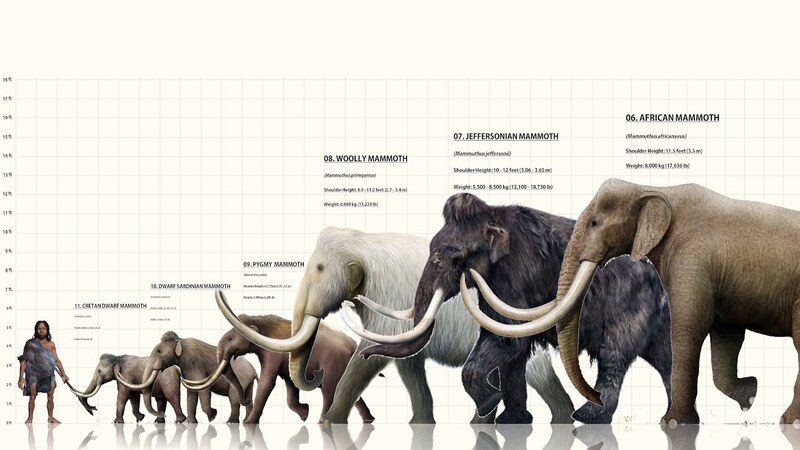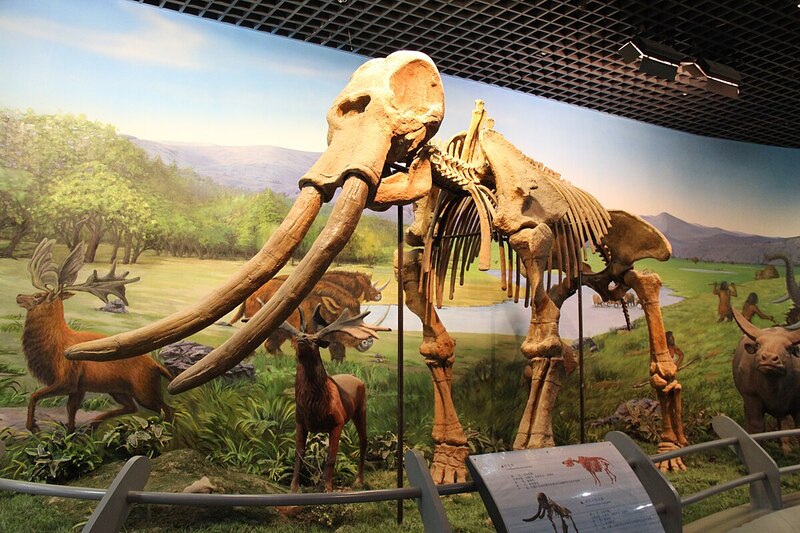Elephants are currently the largest land animals on Earth, with their sturdy limbs and wide feet firmly supporting their huge bodies. However, there were some prehistoric Elephants-Are-Endangered.html">elephants that were even larger in size. Do you know which Elephants-Are-Endangered.html">elephants have become extinct? This article will take you to learn about the top ten extinct ancient elephants, including Nama, Paleocyon, Steppe Mammoth, Mammus, Deinotherium, Paleocyon and Columbian Mammoth. Come and explore together!

1. Nama (weighing more than 20 tons)

Nama was the largest prehistoric elephant and was once considered the largest mammal on land. About 200,000 years ago, they lived in the Yangtze and Yellow River basins in China. According to a femur fossil found in India in 1834, the Nama elephant may have been more than 5 meters tall and weighed up to 20 tons, which is 3 to 4 times the weight of today's elephants.

Their tusks are more than 3 meters long, which can be said to be the giant among elephants and one of the largest land mammals recorded. Nama elephants and other members of the Paleolodon subgenus died out in the Quaternary extinction event in the late Pleistocene, leaving no direct descendants, and are not the ancestors of Asian or African elephants.
2. Ancient Rhomboid elephant(shoulder height 4.2 meters and weight 15 tons)

The ancient Rhomboid elephant is a species that evolved from the ancient Rhomboid elephant of Rui's migrating to Europe. Because they have a pair of slender, relatively upright, downward-growing tusks, they are often called "straight-toothed elephants". Although it is not the highest in the Proboscidea, its huge body cavity makes it the heaviest known Proboscidea animal, weighing up to 15 tons.

The ancient Rhomboid elephant mainly inhabited the warm sparse grassland environment of Europe and had less hair on its body. Its most notable feature is its well-developed melanops, which provide additional attachment points for the neck and shoulder muscles to support its huge head.
3. Steppe mammoth (about 4.5 meters tall and weighing up to 14.3 tons)

The steppe mammoth is an ancient mammal that lived in a cold northern environment and originated in China about 1.7 million years ago. This elephant has a strong physique, thick limbs, four toes, and an abnormally large head.

The largest steppe mammoth can reach about 4.5 meters in height, with a length of about 2.5 meters in front teeth and a weight of 41.3 tons, about three times that of an Asian elephant. It is the tallest known proboscidean animal. Although its hair is sparse or almost non-existent, it has a 9-centimeter-thick fat layer to enhance its ability to resist cold.
4. Mammu Mammus(3.9-4.1 meters tall, 14 tons in weight)

Mammu Mammus lived in Eurasia between 11 million and 2.5 million years ago and is considered one of the largest candidates in the Proboscidea order. Some relatively complete fossils of Mammu Mammus discovered by archaeologists show that they could weigh up to 14 tons and were about 3.9 meters tall at the shoulder.

The most striking feature is their pair of tusks that are more than 4 meters long. This is not only the longest tusk in history, but can even be said to be the longest tooth in the animal kingdom. Initially, this species was classified as the genus of the Brachygnathidae family, but was later reclassified to the genus of the Brachygnathidae family, the same genus as the famous American mastodon.
5. Deinotherium (up to 8 meters in length, up to 4 meters in height and weighing 13 tons)

Among the extinct elephant species, if you want to choose the most fearsome one, Deinotherium is undoubtedly the first choice. This species lived from the middle Miocene to the early Pleistocene. As early as the ancestral elephant period, they began to evolve independently and parted ways with other elephants. Deinotherium has a pair of unique downward-curved tusks on its lower jaw, which are mainly used for digging roots and peeling bark.

Some members of this group are still huge, and their huge physique and strange tusks make them called "terrible beasts". An adult Deinotherium can reach 8 meters in length, 4.5 meters in shoulder height, and weigh up to 13 tons.
6. Palaeolox wretchii(shoulder height 4.3 meters, weight 12.5 tons)

Palaeolox wretchii lived in the early Pliocene and was a key link in the evolution of Palaeolox genus. It was also the largest terrestrial animal in Africa in the Cenozoic era. Its upper limit is estimated to be 4.3 meters in shoulder height, more than 8 meters in length, and weighing up to 12.5 tons, making it one of the largest species in the order Proboscidea. As the earliest member of Palaeolox genus, it is the most primitive species of the genus, and the later Palaeolox wretchii on the Eurasian continent all originated from it.

Historically, Palaeolox wretchii was the leader in Africa. However, about 500,000 years ago, with the advent of the Middle Pleistocene, the Earth entered the Quaternary Ice Age, and Africa gradually became dry, making it difficult for this giant elephant to adapt to the increasingly harsh climate, and eventually became extinct about 450,000 years ago.
7. Columbian Mammoth (shoulder height 4.2 meters and weight 12.5 tons)

Among the top ten extinct elephants, mammoths are famous for their fame, and the Columbian mammoth is the largest animal in the Americas during the Ice Age. They live in an environment rich in food and are almost fearless of any predator when they are adults. The Columbian mammoth has a huge body, with males reaching 4 to 4.3 meters in shoulder height and weighing more than 10 tons, which is comparable in size to the steppe mammoths of Eurasia. The male's tusks are larger than those of females, with a distinct spiral shape and a length of nearly 5 meters.

Unlike real mammoths, they have no hair on their bodies. Although Columbian mammoths are representative animals of the Ice Age, they are actually more sensitive to cold environments and mainly live in the southern part of North America.
8. Yellow River Elephant (4 meters high and nearly 8 meters long)

Among the ancient giant elephants, the most well-known is the "Yellow River Elephant" widely spread due to elementary school textbooks. Its scientific name is Shi's Stegodon. This ancient elephant lived about 3 million years ago and was mainly distributed in the Yellow River Basin in Gansu, China.

The Yellow River elephant can reach a height of 4 meters and a body length of nearly 8 meters. It is one of the largest species in the order Proboscidea. Their incisors are up to 3.03 meters long, and their tusks are about 2 meters long, like two long swords. Therefore, they are called "Yellow River Elephants" because they were unearthed in the Yellow River Basin.
9. Sword-edged elephant (4 meters tall and weighing 11~12 tons)

About 7 million years ago, the climate in Africa had changed to a typical monsoon grassland, and many plants grew abnormally rough. In order to adapt to these difficult-to-digest foods, the order Proboscidea gradually evolved and appeared in the family Elephantidae to which elephants belong. Their distinctive large molars act like millstones, perfect for processing tough plant material. The earliest member of the family was the saber-toothed elephant, which, despite being closely related to its later relatives, looked very different from modern elephants and more like primitive gomphotheres, both of which had four tusks.


The desert saber-toothed elephant could stand up to 4 meters tall at the shoulder and weigh about 11 to 12 tons. The abundance of fossils suggests that they may have been the dominant species in the region at the time. However, the species quickly became extinct more than 5 million years ago, and the family eventually retained only two useful tusks.
10. True Mammoth (3 meters tall and weighing about 6 tons)

Which extinct elephant species are world-famous? Of course, it is the star character in "Ice Age" - the mammoth. People's impression of this animal mostly stays on its huge body, huge tusks and thick long hair, which are also the distinctive features of mammoths. They can adapt to cold climates, with hair on their backs up to 50 cm long, in addition, there is a layer of fluff to provide warmth, and subcutaneous fat can be up to 9 cm thick.

The head of the mammoth is distinctive, with a towering "hump" that can store a lot of fat. They are huge, weighing about 6 tons, and can reach a height of 3 meters. Their tusks are curved and cunning, up to 2 meters long, which is their main defensive weapon.

The top ten extinct ancient elephants are mainly recommended based on the height, weight/popularity of elephants and comprehensive reference to relevant Internet rankings/lists. The data is as of October 10, 2024. If you have any questions, please comment/criticize at the end.
animal tags: elephant
We created this article in conjunction with AI technology, then made sure it was fact-checked and edited by a Animals Top editor.